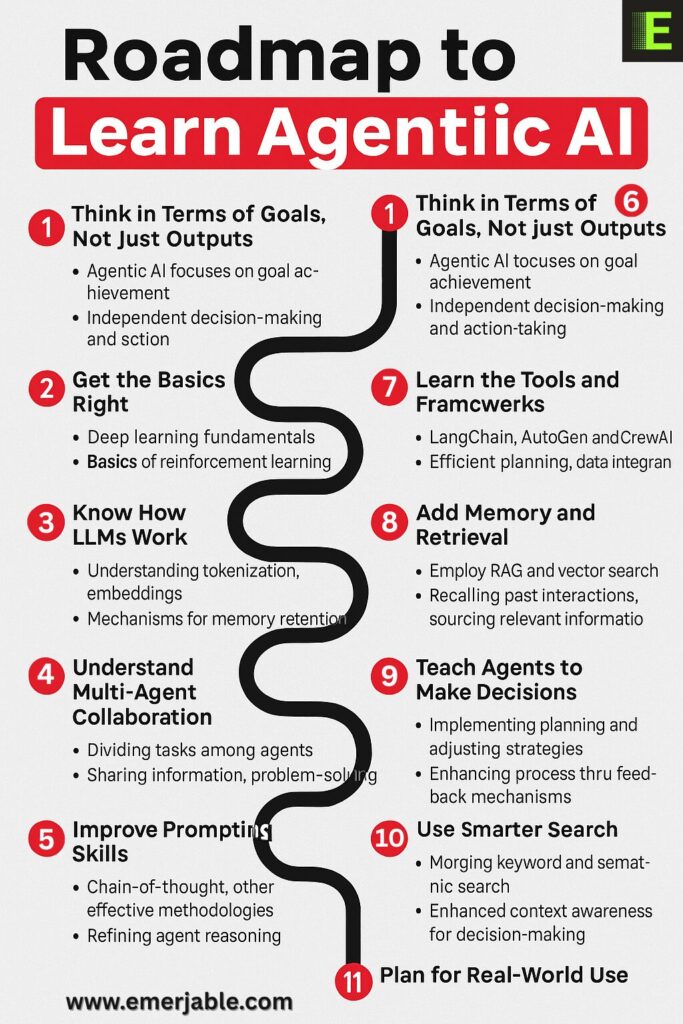We are moving past traditional AI systems that merely generate outputs. The new frontier is Agentic AI—intelligent, autonomous systems capable of planning, decision-making, tool use, and continual learning. If you’re already experimenting with AI agents, this guide will show you how to elevate your skills and build personal AI agents quickly and efficiently.
This is your practical blueprint to evolve from using agents to designing scalable, goal-driven systems that act with purpose.
1. Shift Focus from Outputs to Outcomes
AI agents are no longer just assistants—they are autonomous entities. Start designing agents with:
- Defined goals instead of prompts
- Task success criteria
- Dynamic feedback loops for continuous improvement
Example: A personal coding assistant that not only writes code but also runs tests, logs errors, and iterates until a goal is met.
Tools: CrewAI, LangChain’s PlanAndExecute agent, AutoGen custom agent.
2. Reinforce Core Concepts with Practical Integration
Apply your foundational knowledge to real scenarios:
- Use reinforcement learning to fine-tune decision paths
- Integrate meta-learning models for adaptability
- Deploy deep learning modules for image, speech, or pattern recognition
Example: A self-improving trading bot that adjusts strategies based on market feedback.
Tools: Ray RLlib, Stable-Baselines3, MetaGPT.
3. Master the Agentic Stack: LangChain, AutoGen, CrewAI
Get more from these frameworks:
- LangChain: Build pipelines with memory, tool use, and nested agents
- AutoGen: Create chat-based workflows with multiple agents and human-in-the-loop checkpoints
- CrewAI: Coordinate agents in specialized roles with defined responsibilities
Example: An AI-powered content pipeline using agents for ideation, writing, SEO, and publishing.
Tools: LangChain Templates, AutoGen Studio, CrewAI CLI.

4. Engineer LLMs as Reasoning Engines
Transform LLMs from responders to thinkers:
- Add adapter layers for domain-specific tasks
- Connect to vector DBs for contextual memory
- Augment with symbolic reasoning (e.g. Logic, Tools)
Example: An AI legal advisor that combines precedent search with logical inference.
Tools: LlamaIndex, LangChain Tool use, Microsoft Guidance.
5. Build Cooperative Multi-Agent Systems
Enable collaboration:
- Use messaging protocols between agents
- Delegate subtasks based on capabilities
- Apply distributed compute models for scaling
Example: A research assistant team—scraper, summarizer, validator—working in sync.
Tools: CrewAI, AgentVerse, AgentCloud.
6. Implement Long-Term Memory with RAG + Vector DBs
Enhance memory and retrieval:
- Store context in FAISS, Weaviate, or Qdrant
- Design memory schemas with timestamps and metadata
- Tune retrievers using semantic relevance
Example: An AI therapist that remembers user history and adapts tone over time.
Tools: Pinecone, LlamaIndex, ChromaDB, Haystack.
7. Autonomous Planning and Self-Correction
Make agents adaptable and resilient:
- Build planners that dynamically adjust steps
- Monitor task execution with evaluation functions
- Use reflection loops for improvement
Example: A sales automation agent that adapts its pitch after customer response analysis.
Tools: ReAct framework, LangGraph, EvalAgent.
8. Prompt Engineering as Thought Architecture
Design systems through prompts:
- Develop prompt chains that evolve based on state
- Use advanced techniques: CoT, ReAct, Tree of Thought
- Integrate meta-prompts to control flow
Example: A multi-step customer support bot that solves issues without escalation.
Tools: PromptLayer, FlowiseAI, PromptHub.
9. Build Smart Feedback Loops and Logging Pipelines
Drive continual learning:
- Capture logs for analysis and fine-tuning
- Annotate failures for supervised updates
- Feed real-world usage data back into training
Example: A content rewriter bot that improves style based on user edits.
Tools: Langfuse, Arize AI, Weights & Biases.
10. Enhance Search with RAG + Semantic Layering
Boost retrieval:
- Combine dense + sparse search models
- Layer rerankers for precision
- Use context-aware query transformation
Example: An academic search agent that fetches sources based on reasoning chain.
Tools: Cohere Reranker, Haystack Retriever, HybridSearch.
11. Architect for Real-World Environments
Move to production-ready:
- Expose agents via REST or GraphQL APIs
- Host on scalable clouds (AWS Lambda, Vercel, GCP Functions)
- Instrument with observability tools
Example: A personal health coach agent accessible via a web dashboard and mobile app.
Tools: FastAPI, Docker, OpenTelemetry, Supabase.
12. Solve High-Value Problems With Agents
Deploy agents for ROI:
- Use agents in devops, research, customer support, finance, or personal productivity
- Track KPIs for task completion, cost savings, or user retention
- Build agent personas for reuse
Example: An AI investor agent that tracks, analyzes, and reports on portfolio trends.
Tools: Zapier for automation, Airplane.dev for workflows, Custom CrewAI setups.
Final Blueprint: From User to Architect – Agentic AI
You’re no longer just using AI agents. You are now building systems that:
- Think independently
- Act strategically
- Evolve autonomously
Start creating personal agents today with modular codebases, smart prompts, and scalable infrastructure. This is the next level of AI engineering.

